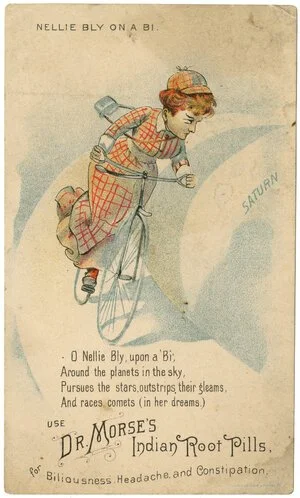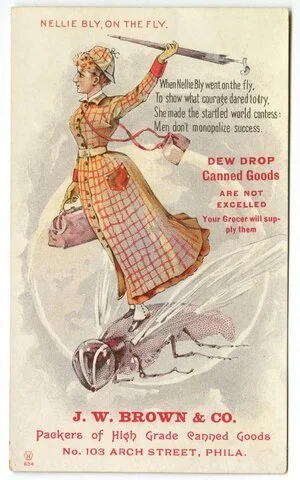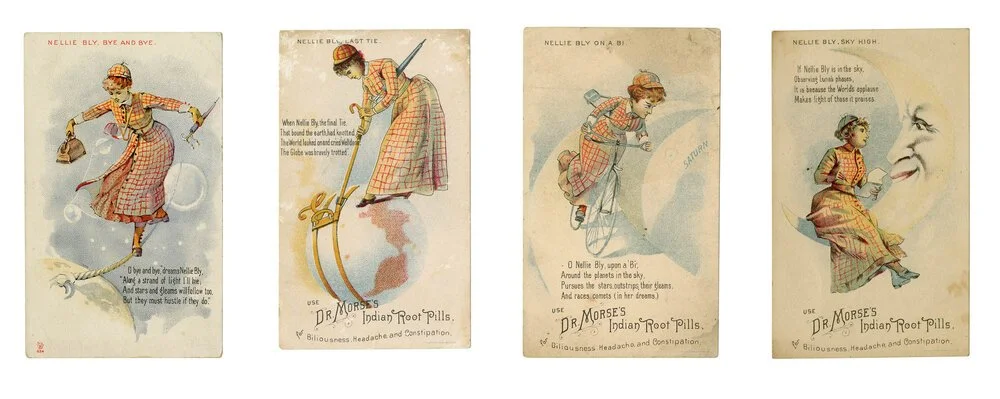What Nellie Bly Taught Me
When I was growing up my mother had a framed series of trading cards of the journalist, adventurist, and proto-feminist Nellie Bly hanging in her dressing room.
These images of a Victorian-era woman, trimly dressed in a traveling coat and hat exhibiting feats of daring-do fascinated me. The cards depicted her interviewing the moon, riding a fly like a skateboard, biking along a ring of Saturn, all the while maintaining an image of confident determination. I stared at the cards for hours, trying to understand what they were depicting? Who was this woman, Nellie Bly? And what exactly was she doing?
Nellie Bly was born Elizabeth Jane Cochrane on May 5, 1864, in a suburb of Pittsburgh. As a teenager, she responded to an article in the Pittsburgh Dispatch entitled "What Girls Are Good For," which stated that girls were principally for birthing children and keeping house. The editor, George Madden, was impressed with her passion and ran an advertisement asking the author to come forward. Her first article, entitled "The Girl Puzzle," described the effect of divorce on women; in it, she argued for divorce laws reform. Madden offered her a full-time job. Cochrane adopted the pen name "Nellie Bly," after a character in the popular song "Nelly Bly" by Stephen Foster.
As a writer, Nellie Bly focused her early work for the Pittsburgh Dispatch on working women's lives, writing a series of investigative articles on women factory workers.
In 1887 Bly was hired by Joseph Pulitzer as a journalist for his newspaper, the New York World. She went undercover to investigate brutality and neglect reports at the Women's Lunatic Asylum on Blackwell's Island.
Working undercover, Bly was committed to the asylum. There she experienced the deplorable conditions firsthand. After ten days, she was released. Her report caused a sensation, prompted the asylum to implement reforms, and brought her lasting fame.
In 1888, Bly suggested to her editor at the New York World that she take a trip around the world, attempting the fictional Around the World in Eighty Days (1873). On November 14, 1889, she boarded the Augusta Victoria, a steamer of the Hamburg America Line, and began her 40,070-kilometer journey.
She took with her the dress she was wearing, a sturdy overcoat, several underwear changes, and a small travel bag carrying her toiletry essentials.
During her travels around the world, Bly went through England, France, the Suez Canal, Hong Kong, and Japan. The development of transatlantic telegraph cable networks and the electric telegraph allowed Bly to send short progress reports.
Bly traveled using steamships and railroads. As a result of rough weather on her Pacific crossing, she arrived in San Francisco on the White Star Line ship RMS Oceanic on January 21, two days behind schedule. Pulitzer chartered a private train to bring her home. She arrived back in New Jersey on January 25, 1890.
Just over seventy-two days after her departure from Hoboken, Bly was back in New York. She had circumnavigated the globe, traveling alone for almost the entire journey. Bly's voyage was a world record.
Nellie Bly's world travels resulted in the trading cards that inspired me when I was young. What I admire most about Nellie Bly is that she was an independent woman who accomplished incredible feats of daring to uncover the truth and report it. Her revelations inspired reforms and policy change.
When my mother moved homes, she gave away the Nellie Bly cards. I've missed them ever since. Recently I saw one online, and my childhood memories and fascination came rushing back! I've purchased prints of the original cards and have them hanging on the wall of my office.
Seeing Nellie's cards in my office reminds me of the power of words to enact change and improve lives. At Studiolo Secondari, I help my customers who are thought leaders in Scholarship, Policy, and Philanthropy develop publications that inspire progress. In my own way, I’m following Nellie’s lead. That’s what Nellie Bly taught me.





